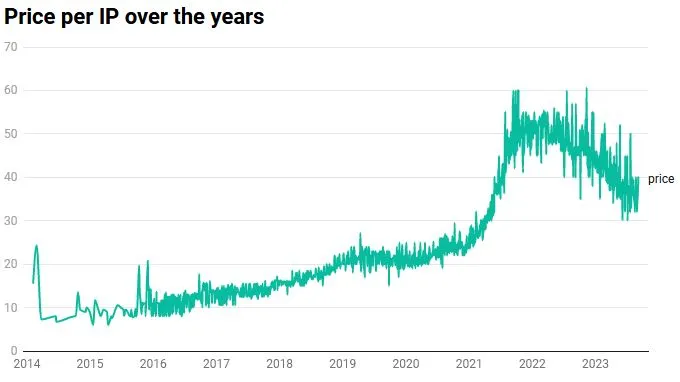AWS to Charge Public IPv4 Addresses
4.3 Billion IPv4 Addresses are Exhausted
Published Feb 8, 2024
Last Modified May 21, 2024
- Introduction
- AWS Announcement
- The Exceptions
- Strategies to Optimize Public IP Usage
- Embracing the Future
- Conclusion
The original pool of IPv4 addresses numbered less than 4.3 billion addresses and by the late 1980s, as Internet growth exploded, Internet Assigned Numbers Authority (IANA) managers foresaw that the available pool of IPv4 addresses would be exhausted in just a few years.
Today all 5 regional Internet registries (RIRs) have already exhausted their top-level IPv4 addresses. (often referred to as IPv4 address exhaustion).
- Southeast Asia/Oceania: 15 April 2011
- Latin America/Caribbean: 10 June 2014
- North America: 24 September 2015
- Africa: 21 April 2017
- Europe/ME/Central Asia: 25 November 2019

Knowing that the cost to acquire a single public IPv4 address has skyrocketed, surpassing a 300% increase over the past 5 years, Amazon Web Services (AWS) has recently rolled out a significant change that will have a direct impact on businesses relying on them for their cloud services.
The number one cloud provider announced that it will “charge users for the use of public IPv4 addresses, regardless of whether they are attached to a service or not”.
AWS’s decision to charge for public IPv4 addresses isn’t solely driven by a desire to combat rising costs and increase revenue but to encourage the adoption of IPv6.
In the current model, AWS charges customers for Public IPs only when an Elastic IP (static) is not associated with a running EC2 instance or an instance with multiple Elastic IPs.
Effective February 1, 2024, every resource with a Public IPv4 address (NAT Gateway, EC2 Instance, Load balancer, VPN etc.) will be charged $0.005 per IP per hour.
Although this may not appear significant on an individual basis, when multiplied across numerous IP addresses employed in various services, it can significantly impact AWS monthly bills.
The only exception to this will continue to be the AWS Free Tier for EC2, which will include 750 hours of public IPv4 address usage per month for the first 12 months, effective February 1, 2024.
You will also not be charged for IP addresses that you own and bring to AWS using Amazon BYOIP.
Below are some strategies to optimize the use of your public IPs and minimize the impact of the upcoming charges:
- Closely monitor your public IP usage: In my upcoming article I will discuss about the two new features AWS introduced to help track and monitor idle and in-use public IPv4 addresses, estimate future costs, and identify opportunities for optimization.
- Identify and remove unused public IPs: Perform a comprehensive assessment of your cloud infrastructure to identify and assess any publicly assigned IP addresses that are currently not in active utilization.
- Tag Public IP costs: Initiate the process of tagging your Elastic Network Interfaces (ENIs) to facilitate cost filtering in AWS Cost Explorer and Cost and Usage Reports (CUR).
- Utilize private IPs for internal communication: Optimize your network architecture by maximizing the use of private IP addresses within your Virtual Private Cloud (VPC), minimizing reliance on public IPs whenever feasible.
- Consider AWS NAT Gateways: If your demand for public IP addresses is minimal, contemplate using AWS NAT Gateways to consolidate and share a singular public IP address among multiple instances efficiently.
- Explore alternatives: For specific services, explore other alternatives such as AWS PrivateLink, which facilitates private communication without the necessity for public IP addresses.
While optimizing your usage of public IPv4 addresses remains crucial, the ultimate solution lies in embracing IPv6 where the long-term benefits are undeniable.
Engineers can start by familiarizing themselves with IPv6 and create a hybrid environment that supports both IPv6 and IPv4, enabling internet access via IPv6 while simultaneously supporting IPv4 for incoming traffic from your Load Balancers and if your environment does not require IPv4, the IPv6-only subnets solution can be used instead.
The announcement made by AWS is a significant change that requires careful consideration and strategic planning and while it might have caught you off guard, it’s important to note that they are equipping customers with tools to help track and monitor idle and in-use public IPv4 addresses, estimate future costs, and identify opportunities for optimization and also providing the opportunity to transition to solutions that don’t incur charges for public IP addresses.
However, not doing anything could lead to unexpected costs and substantial bills.
If you enjoyed this article and found it helpful, please don’t forget to leave a heart ❤, comment 💬, clap 👏🏻, and share ➦ it to show your support.
Also, don’t forget to connect, follow me for more articles and support me by buying me a coffee. :-) Thank you!
